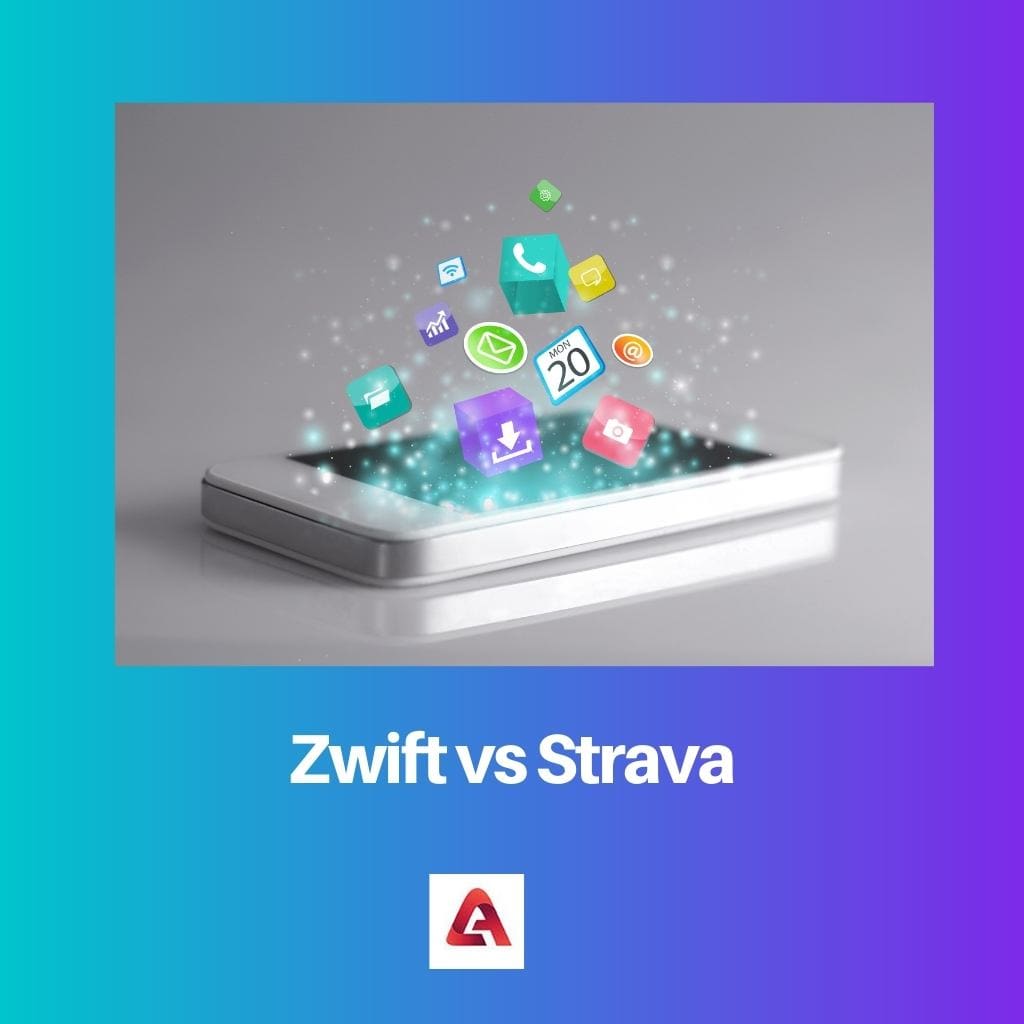Zwift is primarily a virtual cycling platform that allows users to engage in interactive, immersive rides with simulated landscapes and structured workouts. Strava, on the other hand, is a social fitness app that focuses on tracking and sharing real-world activities, fostering a community of athletes.
Key Takeaways
- Zwift is an online cycling game that allows users to ride in virtual environments, while Strava is a social network for athletes to share and compare their workouts.
- Zwift offers a more immersive experience, complete with virtual races and structured workouts, while Strava provides an in-depth analysis of workout data and social features.
- While both are useful for tracking progress and staying motivated, Zwift is best for indoor cycling workouts, while Strava is better for outdoor activities and tracking overall fitness progress.
Zwift vs Strava
The difference between Zwift and Strava is that Zwift creates a virtual environment to cycle in. This app’s interface looks like a game that requires a cyclist to complete certain targets to progress.

Strava, on the other hand, is an app that maps and calculates the distance one cycles outdoors.
Comparison Table
| Feature | Zwift | Strava |
|---|---|---|
| Primary Focus | Indoor cycling training platform | Social fitness tracking app |
| Functionality | Virtual cycling world with gamified training, group rides, and races | Tracks and analyzes outdoor activities (cycling, running, swimming, etc.) |
| Cost | Paid subscription required | Free basic version, premium subscription available |
| Real-time experience | Yes, interact with other riders in virtual world | No, individual activities only |
| Training plans | Yes, various training plans and workouts offered | Limited training plans, user-created |
| Metrics | Detailed power, speed, cadence, heart rate data | Tracks basic metrics like distance, pace, elevation gain |
| Community | Strong online community within Zwift | Large, global fitness community |
| Social sharing | Can share activities within Zwift and on social media | Extensive social sharing features |
| Offline functionality | Limited functionality, some features require internet connection | Full functionality available offline |
| Equipment compatibility | Requires compatible smart trainer and indoor cycling setup | Works with various fitness trackers and GPS devices |
What is Zwift?
Zwift is an online platform that allows cyclists and runners to engage in virtual training and racing in a digital environment. It was developed to make indoor training more interactive and enjoyable. Here are the key details about Zwift:
- Virtual Environment:
- Zwift provides a virtual world where users can cycle or run using their stationary bikes or treadmills. The platform uses 3D graphics to create immersive landscapes and routes.
- The virtual environment includes various terrains, such as city streets, mountains, and even fantasy landscapes, adding variety to the workouts.
- Equipment:
- To use Zwift, users need compatible equipment. For cycling, this includes a stationary bike, a trainer (to measure power output), and a device to run the Zwift app. For running, a treadmill and a compatible device are necessary.
- Interactive Training:
- Zwift offers structured training programs for users looking to improve their fitness or prepare for specific events.
- Workouts can be customized based on the user’s fitness level, goals, and time available. These workouts can include interval training, endurance rides, and more.
- Multiplayer and Social Features:
- One of Zwift’s unique aspects is its multiplayer functionality. Users can train and race with others from around the world in real-time.
- Social features include the ability to send messages, give “Ride On” thumbs-ups to other participants, and join group rides or races.
- Racing and Events:
- Zwift hosts a variety of events, including races, group rides, and challenges. These events are scheduled and offer participants the opportunity to compete against others.
- There are also virtual replicas of real-world cycling and running events, allowing users to experience the atmosphere of famous races from the comfort of their homes.
- Integration with Smart Devices:
- Zwift is compatible with various smart trainers, power meters, heart rate monitors, and other fitness devices. This integration enhances the accuracy of the virtual experience by reflecting changes in resistance based on the terrain or workout intensity.
- Subscription Model:
- Zwift operates on a subscription-based model. Users pay a monthly fee for access to the platform’s features and events.
- The subscription fee may vary based on the user’s location.

What is Strava?
Strava is a popular platform that combines social networking with fitness tracking, catering to athletes and fitness enthusiasts. It has gained widespread recognition for its unique features and community-driven approach to physical activity.
History and Founding
Strava was founded in 2009 by Mark Gainey and Michael Horvath, former Harvard University rowers. The company’s headquarters is located in San Francisco, California. The founders aimed to create a platform that not only tracked individuals’ workouts but also fostered a sense of community and healthy competition among users.
Key Features
1. Activity Tracking
Strava allows users to track various activities, including running, cycling, swimming, and more. Users can record their workouts using GPS-enabled devices, such as smartphones or dedicated fitness trackers.
2. Segments
One distinctive feature of Strava is the concept of “segments.” Segments are user-defined portions of routes where athletes can compete for the fastest time. This competitive element adds a gamified aspect to the platform, encouraging users to push their limits.
3. Social Networking
Strava emphasizes social interaction among its users. Athletes can follow each other, give and receive “kudos” (similar to likes), and comment on each other’s activities. This social component enhances motivation and creates a supportive community.
4. Challenges
Strava regularly organizes virtual challenges to motivate users to achieve specific fitness goals. These challenges can be based on distance, elevation, or time, providing an additional layer of engagement for the community.
5. Training and Analysis
Users can analyze their performance through detailed statistics provided by Strava. The platform offers insights into pace, distance, elevation gain, heart rate, and more. Athletes can use this information to tailor their training and improve their overall fitness.
Premium Membership
Strava offers a premium subscription called Strava Summit, providing additional features such as personalized coaching, advanced performance metrics, and exclusive access to training plans.

Main Differences Between Zwift and Strava
Zwift:
- Virtual Cycling Platform:
- Zwift is primarily a virtual cycling platform that allows users to engage in interactive, multiplayer, and immersive cycling experiences.
- Indoor Training:
- Designed for indoor training, Zwift uses smart trainers to simulate real-world terrain, offering a variety of courses and workouts.
- Interactive Gameplay:
- Users can ride with friends, join races, and participate in structured workouts with interactive elements, making it a more gamified experience.
- Subscription-based Model:
- Zwift operates on a subscription-based model, requiring a monthly fee for access to its features and virtual environments.
- Equipment Compatibility:
- Zwift is compatible with various smart trainers, power meters, and other cycling-related devices to enhance the virtual cycling experience.
- Social Integration:
- Offers social features, allowing users to connect with friends, join group rides, and participate in virtual events.
Strava:
- Activity Tracking:
- Strava is primarily an activity tracking platform that records and analyzes various outdoor activities, including cycling, running, and more.
- Real-world GPS Tracking:
- Focuses on tracking real-world outdoor activities using GPS data, providing detailed insights into routes, elevation, speed, and more.
- Segment Challenges:
- Strava is known for its segment challenges, allowing users to compete for the best time on specific segments of routes, fostering a competitive element.
- Free and Premium Features:
- While Strava offers a free version, it also provides premium features through a subscription, including more in-depth analysis and training metrics.
- Social Network for Athletes:
- Acts as a social network for athletes, where users can follow each other, give and receive kudos for activities, and share achievements.
- Compatibility with Various Activities:
- Strava is versatile and supports a range of outdoor activities beyond cycling, making it suitable for runners, hikers, and other athletes.


